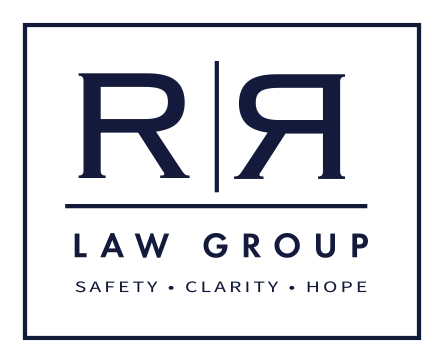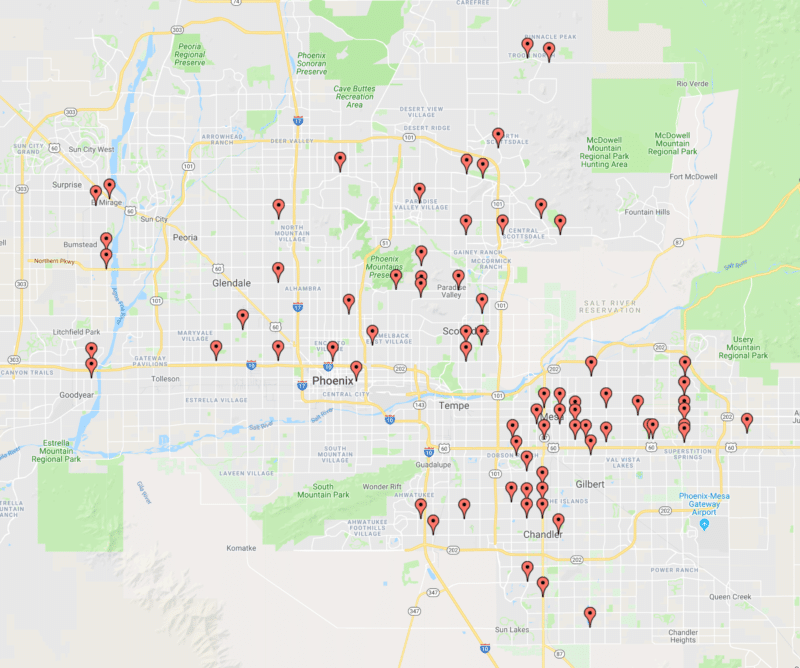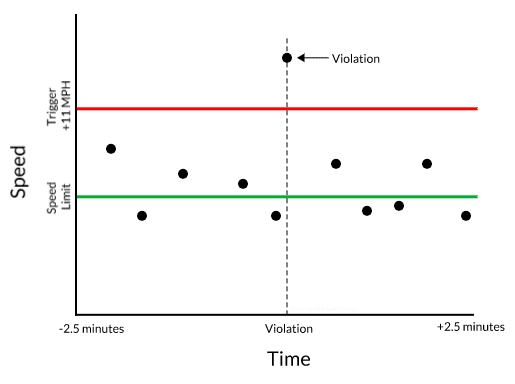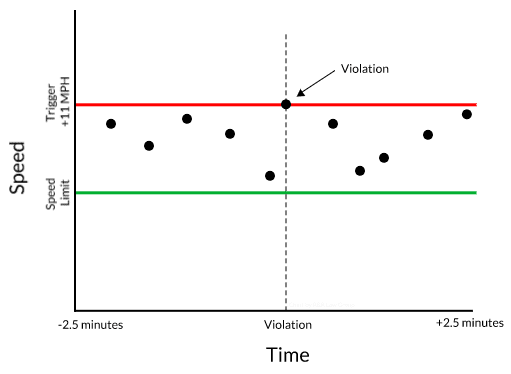Arizona Photo Radar Enforcement Defense Guide
If you are visiting this page it is likely you have the displeasure of having received a photo radar citation.
This page is meant to provide the most comprehensive defense guide to Arizona photo radar violations available.
The vast majority of questions we receive are answered in the content that follows, but if after having reviewed this guide you still have questions, please submit them using the form at the end.
The following (very long) video explains a great deal of the content, but please be sure to read the guide for additional screen shots and explanations on the best practices in defending yourself from these violations.
Where are the traffic cameras located?
Scottsdale City
- Shea and 120th St.
- Pima and Hualapai
- McDowell and Scottsdale
- Scottsdale and Frank Lloyd Wright
- Scottsdale and Thomas
- Scottsdale and Shea
- Shea and 90th St
- Thomas and Hayden/80th St
- Rio Verde at 11300 Block
- Dynamite Blvd at 10300 Block
- Frank Lloyd Wright and Greenway Hayden Loop
- Frank Lloyd Wright and Cactus
- Hayden and Chaparral
Paradise Valley
- Tatum and Lincoln (all 4 directions)
- Tatum and McDonald (NB & SB)
- Tatum and Desert Jewel (NB & SB)
- Lincoln and Mockingbird (EB & WB)
- Lincoln and Palo Cristi (36th St) (EB & WB)
Phoenix
- 12th St and Camelback
- 16th St and Jefferson
- 53rd Ave and Indian School
- 24th St and Thomas
- Central and McDowell
- 67th Ave and McDowell
- 35th Ave and McDowell
- 50th St and Ray
- 35th Ave and Cactus
- Tatum and Thunderbird
- 7th St and Bell
- 35th Ave and Glendale
Mesa City
- Alma School/Guadalupe
- Country Club/Southern
- Gilbert/Baseline
- Stapley/Southern
- Mesa Dr/Broadway
- Power/Broadway
- Power/McKellips
- Broadway/Stapley
- Country Club/University
- Gilbert/McKellips
- Higley/Southern
- Stapley/Main
- Power/Hampton
- Power/Southern
- Broadway/Extension
- Southern/Dobson
- Greenfield/Main
- Lindsay/University
- University/Mesa Dr
- Power/Main
Mesa School Zones
- Franklin @ Brimhall
- Fremont Jr High School
- Mesa High School
- Porter Elementary School
- Rhodes Jr High School
- Skyline High School
El Mirage
- El Mirage Rd and Northern Ave
- El Mirage Rd and Olive Ave
- Grand Ave ( US 60) and Primrose St (INACTIVE)
- Thunderbird Rd and 129th Ave
Chandler
- 56th St and Chandler
- Rural and Ray
- Dobson and Warner
- Alma School and Warner
- Alma School and Ray
- Alma School and Queen Creek
- Arizona and Elliot
- Arizona and Warner
- Arizona and Ray
- Arizona and Ocotillo
- McQueen and Chandler
- Gilbert and Riggs
What does Arizona law have to say about photo radar?
Arizona law allows cities to operate photo enforcement systems. Cities use two companies primarily, RedFlex and American Traffic Solutions. These companies sign contracts with individuals cities to run the photo radar programs. They make money, and the city makes money. In fact, the city of Scottsdale generates nearly $4 million dollars a year snapping photos of unsuspecting drivers.
The problem with photo radar is that most drivers are completely unaware that they have been cited. It is not until weeks later when they receive a citation that they become aware that they have allegedly broken the law.
Moreover, many driver’s accused by photo radar programs are driving perfectly responsibly and in no danger of themselves or society. Traffic cameras are automated to snap photos of drivers under certain conditions, regardless of the surrounding circumstances or conditions. The purpose is not to promote driver safety or safer roadways. The purpose is to generate revenue for the city and the traffic camera companies.
I received a photo radar ticket in the mail, do I have to respond?
Many people have been told that they can “throw away” or “ignore” photo radar citations that have been sent in the mail.
This article will explain that theory in greater detail and provide you with information about your rights according to the law in Arizona.
According to Arizona Revised Statutes 28-1592, if a photo radar ticket is filed with the court against you, it must be served to you within 90 days from the date of the filing with the court.
This means that simply mailing the citation to you via regular mail is not enough!
The citation must be served in order to obtain jurisdiction over you and your case.
Summary: You do not need to respond to a photo radar ticket unless you are served with the ticket (unless you waive your rights – see below).
Please note, if you are served, you will be responsible for the service of process fee. This normally costs around $40-$100 depending upon the jurisdiction.
What is service of process in photo radar cases?
A ticket is formally “served” when a process server physically comes to your house or place of residence and serves you, or somebody of suitable age, residing within your property.
Process servers are not supposed to leave service documents under the foot mat or stuffed in the door jam (although sometimes they do).
They are supposed to physically hand the document to an individual, identify that individual, and take notes regarding the service that occurred.
What if I already contacted the court?
There are several ways you can “waive” your right to be served with the violation.
If you respond to the ticket, the Court may consider your response to be acknowledgement that you received the ticket. This usually happens when:
- You fill out the paperwork they sent to you and send it back (selecting one of the options)
- Sending back a letter or note saying you were not the driver
- Going to court to see the Judge
- Writing the Judge an angry letter
- Going online and requesting an extension of time
Generally, calling the court and asking questions about the tickets are not waivers of service.
Similarly, viewing the pictures or videos online at www.photonotice.com or www.violationinfo.com are not waivers of service.
These website are run by the third party providers who install and operate these cameras.
Will I get served in my city?
Each city has different policies on service, and generally speaking, they are as follows:
Scottsdale Photo Enforcement
Scottsdale is by far the most aggressive photo enforcement entity in Arizona.
In our experience, they serve almost all citations for both in state and often out of state citations.
They are also the only city in Arizona that does alternative service, where they get permission from the Judge to mail a copy via certified mail and tape or post a copy of the citation to your garage or front door.
This is acceptable for service, so do not be surprised if this happens.
Mesa Photo Enforcement
Mesa is very aggressive with serving citations to people living in Arizona and moderately aggressive with people living out of state.
Mesa will not often wait to serve people or give them a “grace period” to respond.
If you are living in state and receive a Mesa citation, expect to get served.
Chandler Photo Enforcement
Chandler does not have a very robust photo enforcement program, but does serve people if they are in the state of Arizona.
This program is not nearly as aggressive as Scottsdale or Mesa.
Paradise Valley Photo Enforcement
Paradise Valley has the least aggressive photo enforcement system in Arizona.
They do not serve people who live out of state, in our experience, and are only moderately aggressive serving people within Arizona.
Their program does seem to be increasing their focus on service in recent months, however, as we are seeing a higher influx of calls from people who have been served.
City of Phoenix Photo Enforcement
The City of Phoenix does have a photo enforcement program, but we do not see a high enough volume of calls to make a conclusive statement about their service of process policies here.
How long do they have to serve me?
The city has 90 days to service you from the date the complaint was filed by the court. It is important to note that the 90 days starts from the date that the complaint was filed with the court and not the date of the violation.
If you believe you were flashed by a photo radar camera but have not received a citation in the mail, please note that the city has up to 60 days from the date of the violation to file the ticket with the court.
Once filed, they then have 90 days to serve you with the citation.
Here is an example of the filing date on a Scottsdale citation:
To calculate the service date deadline, the best tool to use is Wolfram Alpha. Visiting this tool, you can input the date of service and add 90 days to calculate the actual deadline. In this case, enter the information as follows:
Press enter to calculate the result, which will tell you when your service deadline is:
If you have not been served by this deadline, the city cannot legally serve you any further and your ticket will be dismissed.
What is “alternative service”?
Alternative service of photo radar tickets only occurs with tickets from the City of Scottsdale.
Our office has never seen it occur elsewhere.
This happens when a process server attempts to serve you with the violation, but either gives up or is not successful.
When this occurs, they tell their company that their attempts have failed, and then they ask the prosecutor’s office for help.
The prosecutor will then file a request for “alternative service” with the court, and the Judge will almost always grant permission to use alternative service.
This is how it looks in the court docket:
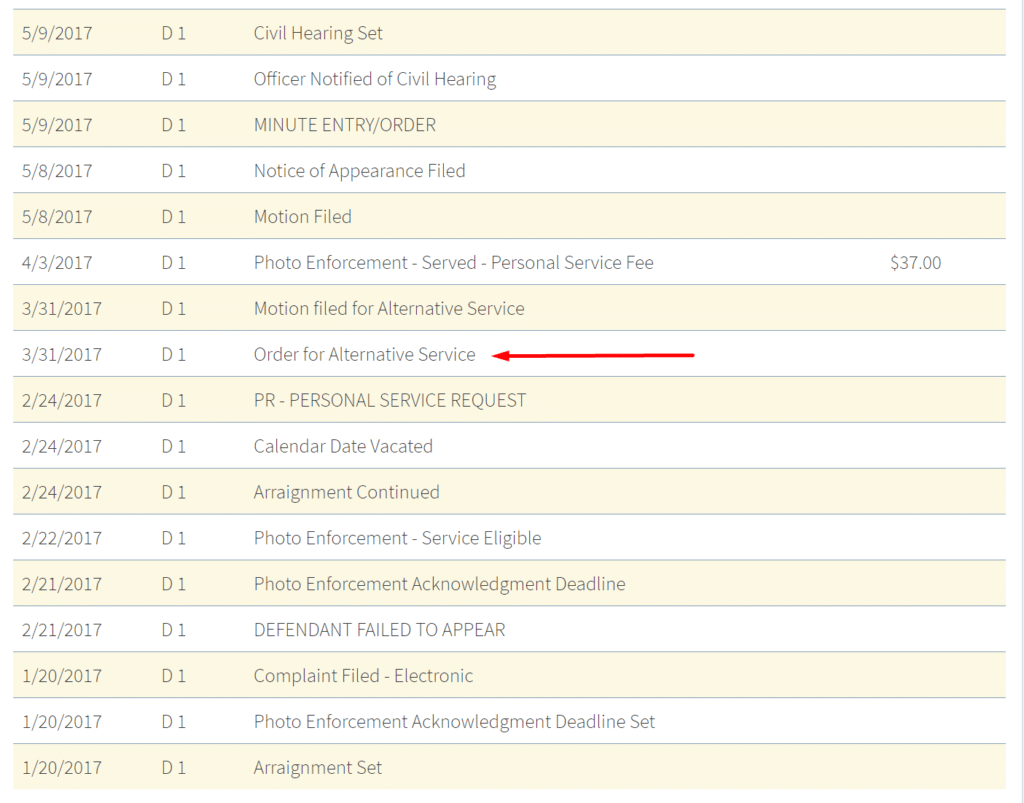
If you see a line that indicates that the Judge issued an “Order for Alternative Service”, this means the Judge is allowing the process service to return to your house and tape a copy of the citation to your front door or garage.
They must also mail you copies via mail and certified mail.
Once they have taped the document to your residence and sent a copy via the mail, service is effective and you must now address the citation.
They no longer need to serve you personally!
If you ignore your next court date, your case will go into a default status, the court will suspend your license, nearly double your fine and no longer allow you to contest your citation.
I was served, now how do you fight a photo radar ticket?
If you believe you were properly served with the ticket and still want to contest it, the case will need to go forward to a hearing.
Civil Traffic Hearing
A civil traffic hearing usually involves several parties:
- The people who want to convict you; the photo radar police officer or traffic aide and in some jurisdictions, the prosecutor
- The defense and your attorney if you choose to hire one to assist you
- The Judge who is supposed to make an impartial ruling based upon the evidence presented
At a civil traffic hearing, the government goes first and presents their evidence against you.
When they have finished, it is the defendant’s turn to ask them questions about what they have presented. It is not the time to present testimony.
After this questioning or cross-examination has been completed, it is now the defense’s turn to present their evidence and testimony.
The Judge has the opportunity to ask follow-up questions.
The Judge will finally issue a ruling.
Government’s Evidence
When the case goes forward to a hearing, the government will usually present a few exhibits:
- The original ticket
- A photo graph of the driver and a corresponding photograph from the motor vehicle department
- A document of calibrations or certifications that correspond to the machine
- A video of the infraction
- A scattergram of the traffic speeds
- A histogram of the traffic patterns
The ‘officer’ will also read from a script about the nature and conditions around the area, identifying points of interest like schools, crosswalks, businesses, parks and other areas.
They use all of this to argue that your driving was not appropriate given all of this evidence.
Argue Against the Evidence
The best method of contesting this evidence is usually to argue that their evidence does not show what they say it shows.
(Any constitutionality, due process, confrontation clause or right to face your accusers routinely fail.)
Instead, it is best to use their own evidence against them.
For example, let’s review the following examples of scattergrams that are often presented by the government.
These charts are used to illustrate the flow of traffic and each vehicles speed over a period of time.
In this chart, the violator vehicle is definitely outside of the general flow of traffic because it is well above the trigger speed and no other vehicles are traveling near that speed.
Contrast that chart, with this chart that is much more reasonable:
In this chart, the violator vehicle trigger the camera, but in reality was travelling much more closely in line with the other traffic in the area.
In this situation, this individual’s speed can be considered to be much more reasonable and prudent given the circumstances, even though there was a citation issued.
Unfortunately, you or your attorney do not have access to this data until the day of the hearing. This is the law in Arizona.
Not the Driver
There are other ways to fight photo radar tickets, including demonstrating that you were not in fact the driver.
If you have evidence that you were not in Arizona at the time of the violation or that another individual was in fact driving, you may be able to persuade the court to dismiss the ticket.
However, this evidence needs to be substantial. Simply submitting the form on the ticket you receive indicating that you were not the driver is usually not enough.
This will almost always result in a response letter saying that you cannot be excluded from being the driver.
Bad Calibration
In some cases, there are faulty machines or bad calibration, such as in this example:
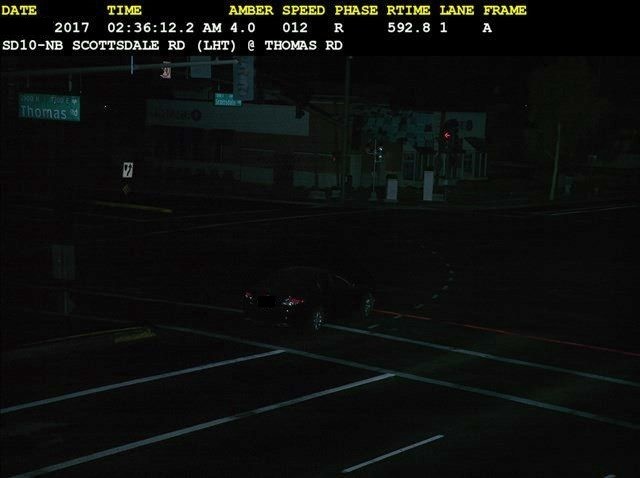
Despite this clear error and problem with the intersection, this driver was still issued a citation, although it was later dismissed.
What are the penalties for photo radar?
Photo radar violations are civil traffic offenses, and usually not criminal.
There are fines and points associated with civil traffic violations:
- Speeding is 3 points, and the fine increases with the speed
- Red Light Violations are 2 point violations and usually approximately a $250 fine
Convictions for red light offenses also requires the completion of Traffic Survival School, which is much different than Defensive Driving School.
Traffic Survival School is an eight-hour course that must be completed in person and it does not dismiss the points. This class normally costs around $150 dollars.
An accumulation of too many photo radar violations or other violations can lead to a license suspension due to points.
The Arizona Motor Vehicle Department begins to penalize drivers when they reach 8 points.
Insurance rates generally increase as well, depending upon the insurance provider, the driver’s record, and the nature of the offense.
However, if insurance rates go up $50/month over a 36-month period, that equals $1,800!
If is important to consider insurance rates when determining whether or not to fight a photo radar violation.
Do I need a lawyer for my photo radar ticket?
You may not need to hire a lawyer if you have received a traffic camera ticket in the mail if:
- You are eligible for Defensive Driving School (this is cheaper than hiring a lawyer)
- You are not in danger of a license suspension
- You are not worried about insurance rate increases
- You are not a commercial driver or a CDL holder
- You were absolutely not the driver of the vehicle (you can sometimes handle this yourself)
- You have not been served or alternatively served
It may be a good idea to hire a lawyer if:
- You are facing a license suspension
- You have multiple citations
- You have a CDL license
How much does a lawyer cost for photo radar tickets?
We have provided the information on this page to assist you in making the determination as to whether or not it is worth it to hire a lawyer. In many cases, it does not make sense from a cost perspective. However, there are certain situations where it is imperative to have a proper defense.
For most violations, our office charges no less than $750 per citation. This cost varies by jurisdiction and the particular situation. For multiple violations, the fee may be reduced based upon what is reasonably required for proper representation.
This cost is more than paying the citation. However, it is important to consider the additional costs that may be imposed upon you in terms of insurances rates and the potential for a license suspension.
What are my chances to beat this ticket?
This is great question and one that is very common.
Unfortunately, it is almost impossible for us to answer until we begin work on your case.
The evidence that we need to review is not available to us until the day of the hearing.
However, in general:
- For speeding violations: the lower the speed the better the chances
- For red light tickets: the lower the “RTIME” is in the photo, the better the chances
Each jurisdiction has unique particulars in how they enforce photo radar violations.
If you are considering hiring an attorney, it is best to have a more thorough consultation regarding the particulars of your case by submitting your citation below.
I have read this page and still want to speak with a lawyer!
Due to a high volume of these tickets being issued every month, we ask that you help assist us in reviewing your case by completing the following form. This will help expedite the process and provide you with a more accurate quote should you decide that you need additional assistance. Thank you for understanding!
